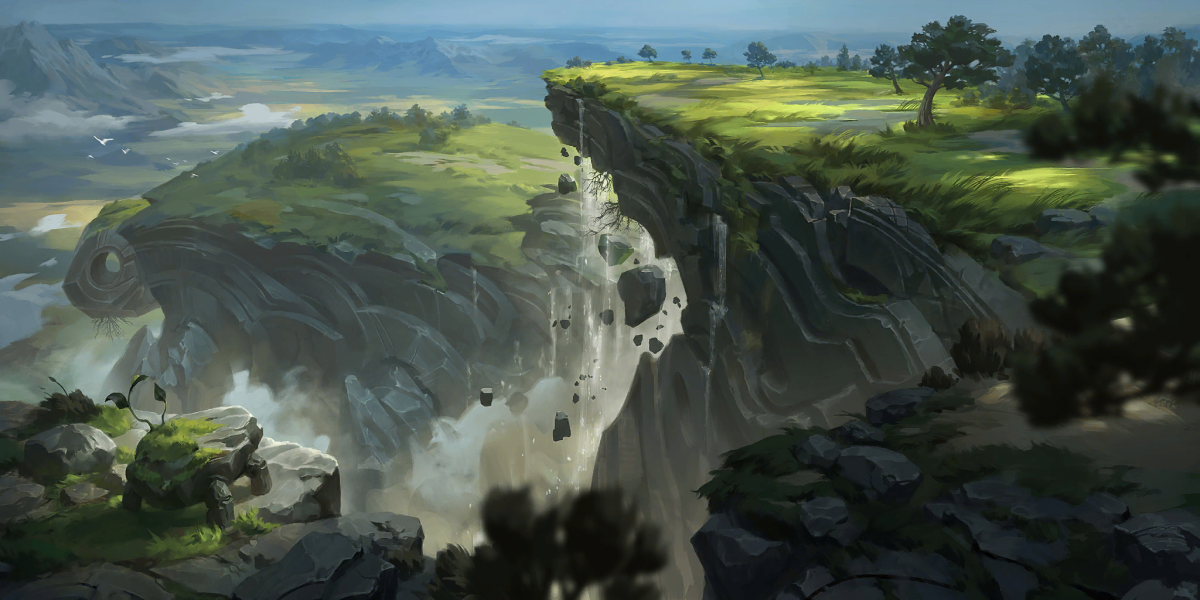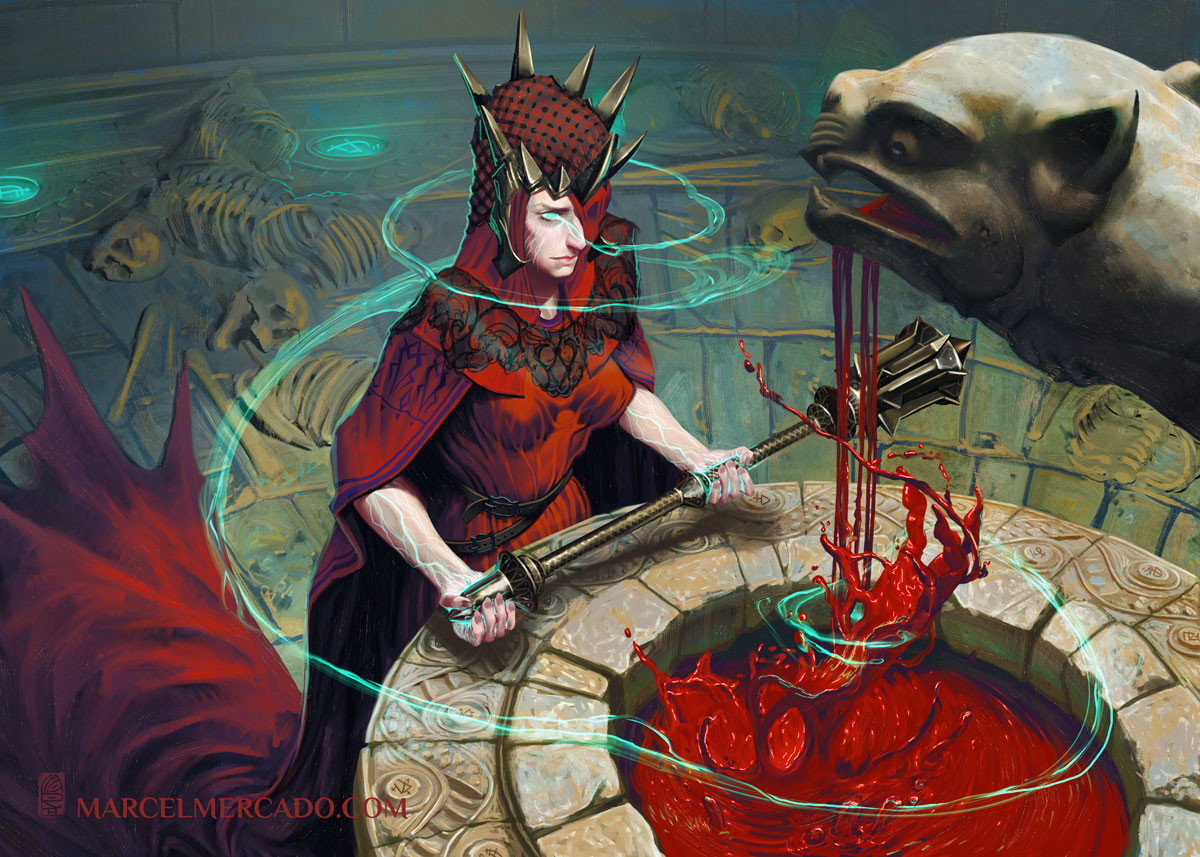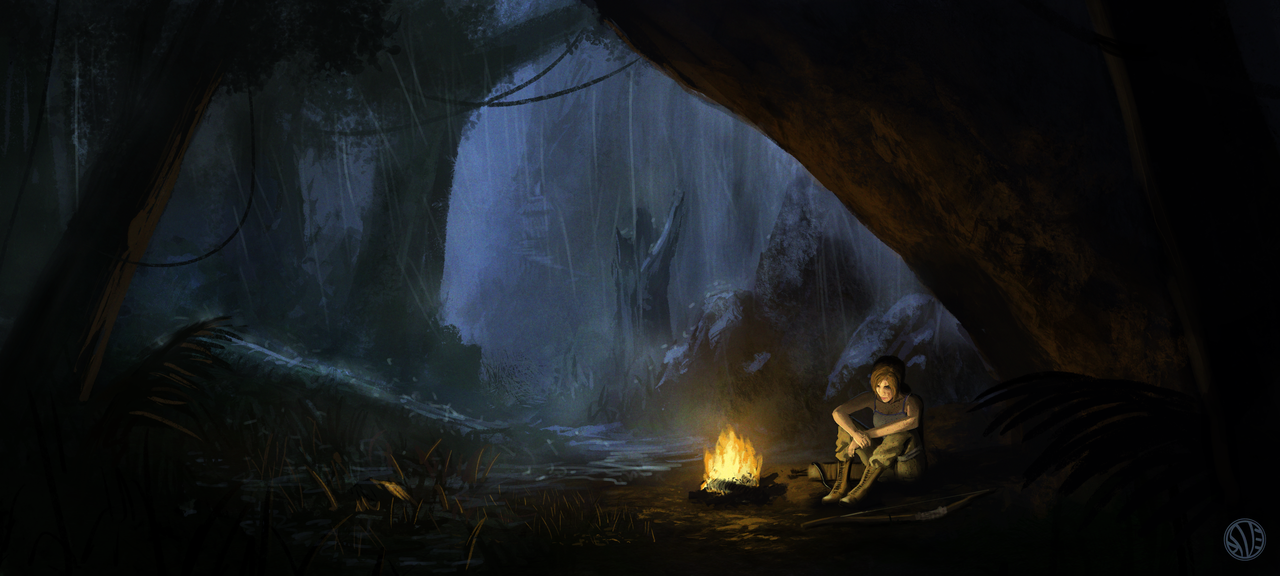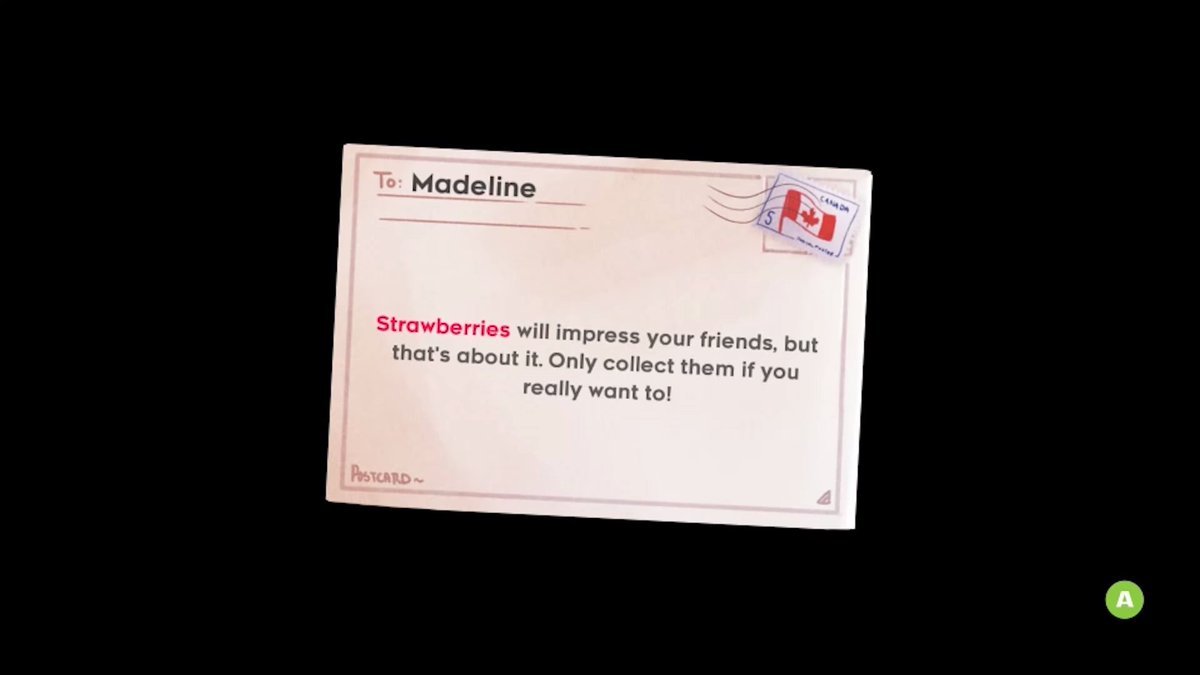It’s been over two years since I set out to patch what I saw as the most glaring hole in 5th edition Dungeons and Dragons. To briefly re-summarize my complaint, the assumption that most parties will face “six to eight medium to hard encounters in a day” simply does not align with the way most 5E DnD plays out. Constructing six to eight consecutive plot-relevant combats is extremely tough on the DM and resourceful players can wiggle their way out of basically anything else. That’s not to say that players are “avoiding playing the game,” more that the smartest thing to do when you’re low on resources and a gaggle of goblins is heading towards you is to avoid them entirely. This leads to a world in which players expect a long rest after every one to two combats and play accordingly, further disrupting combat prep and heavily tilting the power balance between classes towards whoever can deal the most damage on turn one. This in turns forces DMs to push the difficulty of combats higher and higher, as anything short of a “deadly” encounter (as defined by 5E) is essentially a waste of time and mega-deadly encounters themselves can become a coinflip between unexpectedly easy and a TPK based on initiative rolls alone.
In short, over my years of playing vanilla DnD 5E, I found the balance… lacking. On one hand, I could play mechanically “correctly” and exacerbate all the problems I’ve explained above. On the other, I could deliberately handicap my characters’ abilities in the name of roleplay and try to ignore the fact that the struggle and challenge I so desperately sought out was entirely self-imposed. Neither was particularly satisfying.
In July of 2021, I set out to fix these issues as best I could. To those ends, I developed In Darker Times (IDT), a 5E rules supplement aimed at organically creating challenge and tension. The rules supplement itself is here, and here is the post I wrote at the time explaining my issues and goals in more depth.
Since then I’ve played three campaigns that used IDT, of which I was a player in two and a DM in one. Today I’m going to be breaking down my own work: What worked, what didn’t, and what I learned along the way. Let’s go!

Diamond: Medium Rests
Far and away the best piece of IDT is the concept of medium rests. In case you don’t want to open the supplement to read it yourself, here’s how they work, along with the modifications to long rests to make them relevant:
Rule Change – Long Rests
Long rests can only be taken in an area of relative safety such as an inn in a town. Taking a long rest requires a three day period of relative inactivity including as many uninterrupted nights of peaceful sleep wearing no armor and with comfortable conditions. The day between can include light activity such as visiting a market or a library. Characters capable of casting spells cannot cast spells above a cantrip. Any abilities that recharge on any type of rest cannot be used.
New Rule – Medium Rest
Medium rests require only the unaltered long rest requirements: At least six hours of sleep (or equivalent) across an eight hour period. They can be taken in any location, though they still require relative shelter from the elements. A medium rest grants a character:
- Hit dice – one hit die, but no hit points.
- Any ability that recharges on a short rest
- One additional Medium Rest Benefit from the list below.
- More Hit Dice
- Spells
- Abilities
- Remove Exhaustion
I can’t emphasize enough how much these changes hit the nail on the head. Honestly, these two rules alone just about fixed the issues I had with vanilla 5E DnD.
First, the change is intuitive, easy to understand, and cleanly integrates with other core systems. Even players new to DnD as a whole have had no trouble understanding how medium rests work. (This doesn’t yet address the issues I’ve outlined, but it’s a sort of “table stakes.” If the proposed rules were too messy or complex, the cost may outweigh the benefit. Remember this for later…)
Second, they effectively extend the adventuring “day” beyond a single calendar day. Players now have to think about when they’ll reasonable get their next long rest and whether their resource expenditure that day can be paid back with a single medium rest. These changes make easy encounters matter, even if the players have no chance of “losing.” Even losing chunks of health or having to commit resources may matter down the line.
Third, they make the DM’s life drastically easier. Restricting long rests to towns and areas of safety gives the whole rest of the world an implicit challenge, one that before the DM was forced to generate themselves. The DM no longer has to convince the players that the dungeon is scary. It’s scary simply because the players know that once they enter, there is absolutely no way to fully recharge their resources until they leave. (In vanilla 5E, a single Tiny Hut per day generally defeats all but the most dangerous dungeons in a single stroke.)
Fourth and finally, they help correct power balance between classes. Bursty classes that are used to spamming powerful spells until the enemies stop moving have to think twice lest they be caught with their pants (spell slots) down. More sustained martial classes get their day in the sun as they consistently deal solid damage and even get to spend medium rests keeping their health topped off. I can truly say that playing a high level fighter is a blast in IDT, in a way that it simply isn’t in vanilla 5E.
I’ve seen the positive benefits of these changes, from both sides of the looking glass. On the player side, I’ve had to make difficult choices when taking a rest, debating whether to heal up or to get greedy and recharge a powerful ability. I’ve felt the tension slowly build as my party has limped through the wilderness, the nearest town still days’ travel away. I’ve felt the overwhelming relief at finally crawling into an inn and shrugging off all my burdens and passing out in a bed for the first time in a week. It’s a complete synthesis of mind between character and player, a roleplaying gold standard. With these rules, I the character and I the player agree that the wilderness is scary, that even a single wound is of concern, that there’s something special you get about the rest you get in a place of safety as compared to a random clearing in unknown woods. It’s incredible and it’s something you have to see and feel to believe.
From the DM side, I’ve seen how even a low-powered encounter gives my players pause. How longer journeys are contemplated carefully. How every coin and every item they receive is treasured as a future failsafe for a dire circumstance. It’s given me incredible flexibility to challenge my players while not shoehorning in forced, unavoidable combat. It makes DMing for experienced players fun in a way that the vanilla rules simply do not.
If you play or DM in 5th edition, I would highly recommend you consider adding the medium rest and modified long rest rules to your games, even if you don’t read any of the rest of this post!

Rough: Traveling Mechanics
I promised some rough to go along with my diamonds and I intend to deliver. First up, the traveling mechanics. I added these rules in an effort to make long distance travel less hand-wavey. After all, with the new spiffy medium rest rules, shouldn’t traveling from Plainsberg to Delport pose some challenge to the players? I wanted to formalize that challenge, to make the players feel how their characters would feel traversing through an unknown landscape.
To these ends, I created various roles the players could take in their traveling party. One character could scout, another could navigate, a third could forage or make a map. Each would make some number of related skill checks, determining the outcomes for the traveling day. The hope was that these mechanics would create the space for challenge and lead to interesting new developments in the story.
In practice, it ends up being a lot of rolling dice and not a lot of interesting outcomes. On one hand, the players could all roll well, in which case nothing bad happens and the traveling day is uneventful. In this case, it’s essentially the same as if you hadn’t used the mechanics at all. On the other, perhaps the players roll poorly, in which case the players suffer setbacks and injury. In practice, I can say this felt more like an inconvenience than a challenge. Because players weren’t trying to accomplish anything in particular other than make progress in traveling from Plainsberg to Delport, suffering a setback along the way simply wasted time. Either way, the players didn’t end up actually caring about the travel nor the travel mechanics.
In reflection, I think the reason these mechanics fell flat was that I was trying to solve the wrong problem. Travel isn’t interesting. However, the reason it is not interesting isn’t because the mechanics make it boring. It is because it is disconnected from the interesting parts of the game. The way to make travel interesting isn’t to stuff it full of mechanics. It’s to make the travel matter. For example, if there’s some plot in Plainsberg and some plot in Delport, but those two pieces of plot are fully disconnected, no amount of mechanics will ever make the players care about the travel from Plainsberg to Delport. If they take three days to get there and skip into Delport’s front gate, or if they limp in on day eight, spitting blood and fragments of teeth… so what? If the plot doesn’t care, neither will the players.
On the other hand, if the plots in Plainsberg and Delport are connected, then suddenly the travel might matter. If the players learn in Plainsberg that there’s a once a century carnival happening in Delport in five days, suddenly the difference between three and eight days of travel matters.
This burden ends up falling on the DM, but I think it’s a valuable point of (self) feedback nonetheless. Broadly speaking, players rarely want to play DnD for the simulation of walking 100 miles. Either connect that travel to something they do care about (plot, treasure, combat, whatever), or hand-wave it away.
(To be clear, there’s nothing wrong with handwaving travel. In fact, even in an “optimal” campaign, I think most travel can be narrated away. However, it’s a good idea to keep strictly mechanical travel in your back pocket for those few situations where the players’ travel schedule really matters.)

Diamond (With Some Rough): Grievous Injuries
As a long time DnD player there is nothing I dislike quite so much as “going through the motions.” It’s a special kind of frustrating to sit through a 90 minute combat, knowing from turn one that not only is the party certain to win, there is straight up no chance that anything could happen that would matter after a long rest later that night. Thus, one of my goals in IDT was to make sure that even the smallest combat could matter. Even beyond the medium rest additions I’ve already explained, I wanted there to always be a chance, however small, of sustaining a greater injury in battle, one that wouldn’t be gone tomorrow.
Another related area of immersion breaking that I never loved is how 5E handles unconsciousness and death saving throws and what it does to “optimal” healing. “Down” is “down,” after all. If you take 40 fire damage from a powerful fireball, it doesn’t matter if you were at 39 health or 2 health, you’re equally down. This does some really weird stuff to incentives around healing and action economy. Generally speaking, this system means you’re better off waiting till your party members fall unconscious before you heal them. For example, a cure wounds on your 2 health teammate before the fireball hits does absolutely nothing, but a cure wounds immediately afterwards gets them up and fighting again with literally no consequence. Even worse, this effect is far more pronounced at lower levels when healers have fairly few healing spells to go around and enemies don’t have legendary actions that could legitimately kill your unconscious teammate before the healer gets to act. Newer players constantly fall into the trap of healing too early, particularly because the “correct” play is horribly unintuitive and breaks immersion. Who would think that waiting until your barbarian hits the dirt is the right time to spend your healing word? What cleric in their right, in-game mind would wait that long?
In a completely separate column of my DnD hopes and dreams, I’ve always wanted the ability to fight with more strategy and tactics than DnD allows. “Health” is a wonderful abstraction that does away with huge amounts of bookkeeping that would certainly arise without it, but it has the tendency to reduce epic flights into monotonous slapping back and fort to see who can make the other’s red number hit zero first. If I’m an archer fighting a cyclops, shouldn’t I be allowed to try to blind it with a regular old arrow? If I’m a wizard fighting a red dragon, shouldn’t I be able to freeze it out of the sky? And if I’m a monk fighting Strahd, wouldn’t it be awesome to punch him so hard he flies across the entire room and through the wall like a DBZ villain? (Trick question: of course it would be cool!) I’d long assumed, though, that there was no way to unlock the cool without compromising the simplicity offered by health. Gain one, and you lose the other.
Turns out, though, that there was a shared solution to all three problems. Enter the Grievous Injury! I won’t copy paste it all here (the full rules are a lot longer than medium rests; you can read them in the supplement), but I can address the above issues with a few highlights:
- When a creature is knocked unconscious or suffers a critical hit, they have a chance of sustaining a grievous injury.
- The injuries can only be restored by some number of long rests (not medium).
- When a creature is knocked unconscious, the saving throw to not receive an injury is equal to the amount of overflow damage the creature took.
- Starting at fourth level and ever four levels after, player characters gain Griveous Strikes, an ability that lets them deliberately try to inflict an injury.
- The save type and consequence of the injury vary by the type of damage inflicted.
This fairly concise system addresses all of the above points in one neat package. Because injuries take time and resources to remove and critical hits can happen at any time, even a rogue skeleton can inflict a meaningful blow on a high level character. Because the saving throw DC increases with overflow damage, hanging around at 2 health in battle is terrifying and preemptively healing to a safer, higher number is a strategically valid choice. Finally, because the save type and consequences vary by damage type and players can force saves through Grievous Strike, unique and immersive battle tactics open up combat (like punching Strahd through a wall).
All in all, it’s added a lot of fun moments to my games. It allows dramatic range in consequence during combat (that vanilla health simply doesn’t) and helps players who prepare to get an extra little edge on their enemies. Overall, I’d call it a clear win.
The system does have its rough edges, ones that can probably be ironed out with a bit more tweaking. First, the level of severity of injury isn’t perfectly balanced across the injury types. This can be fun when the players are picking damage types (different injuries may be more effective against different enemies), but less fun when an enemy happens to highroll the perfect injury to cripple your abilities. There’s an argument that this is “realistic,” but at the end of the day I’m not sure it’s that fun.
Second, Grievous Strike is only a cool mechanic when it actually works. Otherwise, when you line up your best attack and the enemy saves, the “well, then nothing happens” feels like a bit of a letdown. It also violates my general TTRPG invariant that needless dice rolling should, as often as possible, lead to some kind of outcome. Again, there is an argument that this is “balanced,” (I don’t know if I’m allowed to buff Grievous Strike any further), but again, not sure it’s that fun.
While more work is probably needed here, I’m fairly confident that Grievous Injuries and the associated rules are a net positive to my games and will continue to strive to improve them.

Rough (With Some Diamond): Blood Magic & Chronomancy
Honestly, I kinda let the theming run away with me here. With all the added rulesets around making the world grittier, tougher, darker… it felt almost too obvious that I should build a few extra schools of magic to go along with it. To these ends, I created two additions: Blood Magic and Chronomancy. To fit in with the overall theme of power coming at a cost and persistent consequence, I wanted to build both schools of magic around an inherent drawback. My idea was that both schools would feature very powerful spells (more directly, spells more powerful than the vanilla 5E spells at equivalent level), but that they would have a built in cost that would balance them out.
To keep the flavor and play style of the two separate, I designed two separate cost schemes. For blood magic, every single cast has a cost in health, scaling upwards with spell level. This damage is unpreventable and in some cases even increases the power of the spell as more blood is poured into it. Additionally, after you cast a blood magic spell, you have to make a saving throw to resist the pull of the magic. Fail, and the blood doesn’t come back: Your maximum health is reduced by the damage dealt until you can rest it off of heal it with a restoration style spell. This gives the school an incremental cost, a drip-drip-drip of loss as you cast powerful blood magic spells. One’s amount of dependence is directly measured by loss of maximum health. How weak are you willing to become to unlock great strength?
In contrast, I wanted chronomancy to be less material. Rather than a constant cost to be paid with every spell cast, I created a scheme of slowly building risk. When you cast a chronomancy spell you gain fracture stacks based on the spell level. The stacks themselves do nothing, but you then roll a d100 and compare to your stacks. Roll lower than your number of stacks, and a consequence occurs, ranging from fairly bad to positively catastrophic. On the flip side, fracture stacks slowly fade as time passes naturally; restrain from chronomancy and the issue will resolve itself. However, as time mages know, sometimes there simply isn’t enough time. How much will you risk to do what must be done?
While I find some of the individual spells to be absolute gems and create fascinating play patterns, I need to do a lot of work before they’re truly play-ready. My first few sessions with these new spells showed that they had a number of game-breaking balance issues that had to be patched mid-combat. More broadly, they are probably simply too much to explore in a single campaign, let alone a oneshot. Perhaps picking either blood magic or choronomancy would have let them shine. Trying to cram both in at once was a bit too much, too quickly.

All in all, I’d call In Darker Times a success. I certainly accomplished what I set out to, at a very minimum, and I can easily say that I enjoy playing with these rules more than without them.
As I wrap up my writings about this ruleset, I want to reiterate that DnD, and TTRPGs more broadly, are fun for a multitude of reasons. Every player has their own reasons for playing and different set of activities they are looking to get out of the game. Some who tried IDT found it particularly unfun. In listening to their criticism, they mainly found it unfun because IDT successfully accomplished its goals. For example, some wanted the flexibility and freedom to express themselves in roleplay and combat and didn’t like the way the rulest restricted their resources. Others enjoyed the sensation of being powerful and flattening enemies and didn’t like how the rulset made even previously trivial fights meaningfully challenging. (Notably, I haven’t met a DM who hasn’t liked IDT yet, but that could change.)
These players are completely valid in these opinions. It is totally fair to seek out a game with these qualities and I can certainly say that IDT doesn’t help create such a game. If anything, these discussions point more towards having a meta-conversation with your play group before you start the story about what everyone is looking to get out of the game. Making sure everyone is aligned about where the fun is makes sure you all spend a lot more time having a real great time!
In the meantime, I’m looking forward to even more time.. In Darker Times.
























_screenshot_04.png)




